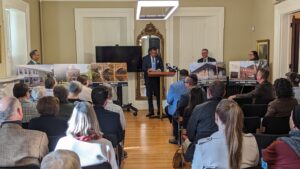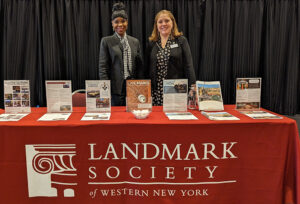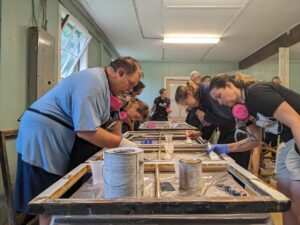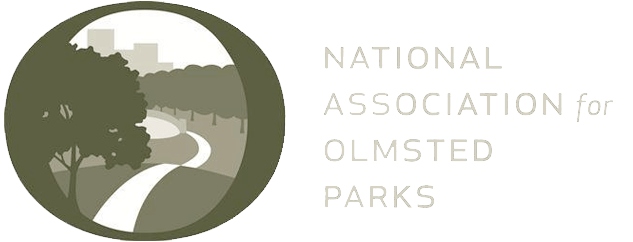I realize that I have been a little late in writing this blog, but trust me I had such a hangover of this trip that it took me this long. It was a four day long motor coach trip. If you are fascinated by architecture, this trip is perhaps the best architectural treat one can get. The combination of the choice of the cities was remarkable. Although settled around the same time and colonial reign, there was such a stark difference in the architectural fabric of the two cities; this difference was something that added the special zing to this trip.
The first stop of the trip was at Quinn’s Inn- historic 1865 built stone building in Ontario. We reached Quebec City that evening around 7pm and checked into grand Le Chateau Frontenac Hotel. Staying in this hotel was the most exhilarating aspect of the trip. Standing high on a bluff with its castle like architecture, the hotel overlooks the mighty St. Lawrence River.
The next morning we started our exploration with a wonderful introductory lecture on the history of World heritage Quebec City by
Dr. David Mendel, a PhD in art history from Laval University. The word
Quebec means where the river narrows. He mentioned that the City was founded as a Trading Post because of its strategic location on a cliff; it was the Gibraltar of North America. Quebec City was the capital of New France, then capital of British North America and today the capital of the province of Quebec. The heart of French culture in North America, with its impregnable fortification walls, the City was divided into upper and lower town. These walls are 60 feet thick with densely packed earth to take the impact of canon fire. Besieged six times in history, Quebec was finally conquered by the British in the Battle of the Plains of Abraham in 1759.
illustrations and photographs.
Following the talk we did a tour of majestic 1893 built Chateau Frontenac, one of a series of “château” style hotels built for the Canadian Pacific Railway company at the end of the 19th and the start of the 20th century. Additions were made to the hotel in 1908 and 1920. This chateau very much had the ancient city character which seeks a promontory. Mr. Mendel also pointed us to the archaeological dig on the site of Governor’s palace right next to the river.
After this we did a walking tour of Upper town which included the Holy Trinity Anglican Cathedral, inspired by St Martin’s church in London, built according to the plans of British officers between 1800 and 1804. Our guide mentioned about the preservation issues involved when restoring such a building.

Our next stop was Seminary of Quebec, founded in 1663, now occupied by the School of Architecture of Laval University. It was fascinating to see the courtyard of this institution around which buildings were designed. It was a beautiful public urban space where school students were playing volley ball.
After this all of us headed to various lunch stops in lower
town and then gathered together for the highlight stop of the day

-Place Royale. This public square, with its houses
for the most part were rebuilt following a fire in lower town in 1682, became known as Place Royale in 1686.
 Around 1960’s following an economic downturn the Government of Quebec
Around 1960’s following an economic downturn the Government of Quebec
launched a major initiative aimed at giving the square the appearance it might have had at the end of French Regime. Being a preservationist, I understand that this could potentially be a controversial topic and many would feel that such a restoration is an insult to the history of the place and is like a Disneyland, creating an artificial world. Personally, I find this approach to be extremely fascinating, I felt it was an architectural marvel and was very intelligently done. All the buildings around the square have different roofing materials ranging from wooden shingles to metal sheeting and showed an evolution in building construction. This space can be treated as a didactic laboratory to illustrate a historical era, a reminder of this period. I felt this approach very much had the potential to be one of the defining guidelines in the rule book of preservation.

Quebec City felt like the closest city to Europe in North America, it was fascinating to see narrow winding streets, historic buildings, criss- crossing multi colored rooflines and alleys leading to landmarks. Although, we are in 21st century, but being in this place was reminiscent of a bygone era. After this, we headed for our architectural tour of the Parliament Building and said goodbye to our guide. This building derives inspiration from the Louvre in Paris and is a fine example of French and English architectural styles. After a break in the evening for an hour, we had a four course extravagant dinner at the hotel at their Le Champlain Restaurant.

The next morning we departed for a new adventure into the city of Montreal. We met our guide Ronaldo (he specialized in food tours and was a major in Sociology) around 11:30 in the morning. He gave us a swift history of Montreal and then we walked through Old Montreal via Place Jacques Cartier, a beautiful public urban space, built by the City in early 19th century. Although there is no trace of a fortified wall now in Montreal, but one existed in mid 1600s.
Following this, we went on a whirlwind bus ride of various neighborhoods of Montreal. We started our tour with St Jacques St- the wall street of Canada leading into Ville Marie, where we went through the Chinatown, Gay Village, Latin Quarter and Le Plateau-Mont-Royal. The most interesting feature of the Le Plateau neighborhood was the Montreal trademark beautifully designed curved exterior staircase. We also made a stop at legendary landscape architect Frederick law Olmstead designed Mount Royale Park and Expo 67 Buckminster Fuller’s geodesic dome site. This tour seemed like a peek into the extensive and eclectic city of Montreal, enough to motivate us to come back again. The third day of the trip ended with laughter, singing and making merry at the Cabaret Du Roy, a theme restaurant in Old Montreal that recaptured the spirit of New France, through its colorful period characters and musicians that played traditional festive music.
For the last  day of the trip we still had two visual treats left, CCA – Center for Canadian Architecture and Notre Dame De Montreal. We had guided tours of both the places. CCA is one of its kind research centre and museum founded on the conviction that architecture is a public concern. The CCA shares the site of the historic Shaughnessy House built in 1874 with a new building integrated in 1989. It is a very sensitive design respectful to its past in terms of mass and design vocabulary. Our tour ended with breathtaking Basilique Notre Dame De Montreal, finest examples of Gothic Revival architecture in North America with a lunch at Restaurant Bonaparte.
day of the trip we still had two visual treats left, CCA – Center for Canadian Architecture and Notre Dame De Montreal. We had guided tours of both the places. CCA is one of its kind research centre and museum founded on the conviction that architecture is a public concern. The CCA shares the site of the historic Shaughnessy House built in 1874 with a new building integrated in 1989. It is a very sensitive design respectful to its past in terms of mass and design vocabulary. Our tour ended with breathtaking Basilique Notre Dame De Montreal, finest examples of Gothic Revival architecture in North America with a lunch at Restaurant Bonaparte.
To me, Mont real felt like the New York City of Canada. The most striking aspect of the city was its vibrancy in all aspects of culture, architecture, demographics, street character, connectivity and life of the city. Although it’s much smaller in scale both in terms of size and population compared to NYC, but its multi-faceted nature makes the city very likable and intriguing.
real felt like the New York City of Canada. The most striking aspect of the city was its vibrancy in all aspects of culture, architecture, demographics, street character, connectivity and life of the city. Although it’s much smaller in scale both in terms of size and population compared to NYC, but its multi-faceted nature makes the city very likable and intriguing.
Overall this tour was certainly one of the best architectural tours one can get. On behalf of the Landmark Society, I would like to thank all the people who took this tour and made it so special. We look forward to having you for many more of our forthcoming trips!
Posted by Nimisha Thakur, Preservation Associate

Around 1960’s following an economic downturn the Government of Quebec
day of the trip we still had two visual treats left, CCA – Center for Canadian Architecture and Notre Dame De Montreal. We had guided tours of both the places. CCA is one of its kind research centre and museum founded on the conviction that architecture is a public concern. The CCA shares the site of the historic Shaughnessy House built in 1874 with a new building integrated in 1989. It is a very sensitive design respectful to its past in terms of mass and design vocabulary. Our tour ended with breathtaking Basilique Notre Dame De Montreal, finest examples of Gothic Revival architecture in North America with a lunch at Restaurant Bonaparte.
real felt like the New York City of Canada. The most striking aspect of the city was its vibrancy in all aspects of culture, architecture, demographics, street character, connectivity and life of the city. Although it’s much smaller in scale both in terms of size and population compared to NYC, but its multi-faceted nature makes the city very likable and intriguing.




